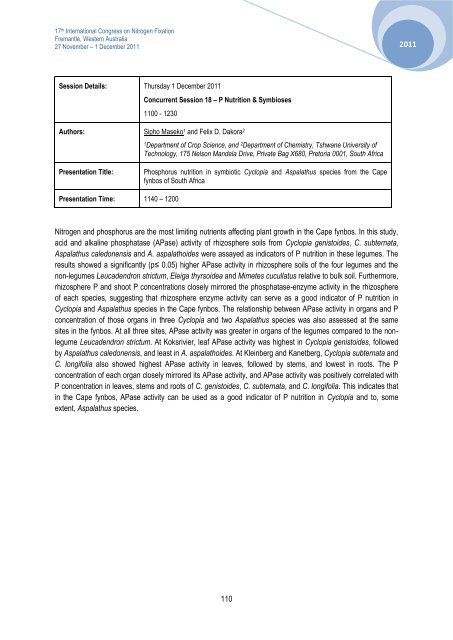IN INOCULANTS Nodulaid - 17th International Nitrogen Fixation ...
IN INOCULANTS Nodulaid - 17th International Nitrogen Fixation ...
IN INOCULANTS Nodulaid - 17th International Nitrogen Fixation ...
You also want an ePaper? Increase the reach of your titles
YUMPU automatically turns print PDFs into web optimized ePapers that Google loves.
17 th <strong>International</strong> Congress on <strong>Nitrogen</strong> <strong>Fixation</strong><br />
Fremantle, Western Australia<br />
27 November – 1 December 2011<br />
Session Details: Thursday 1 December 2011<br />
Concurrent Session 18 – P Nutrition & Symbioses<br />
1100 - 1230<br />
Authors: Sipho Maseko 1 and Felix D. Dakora 2<br />
1 Department of Crop Science, and 2 Department of Chemistry, Tshwane University of<br />
Technology, 175 Nelson Mandela Drive, Private Bag X680, Pretoria 0001, South Africa<br />
Presentation Title: Phosphorus nutrition in symbiotic Cyclopia and Aspalathus species from the Cape<br />
fynbos of South Africa<br />
Presentation Time: 1140 – 1200<br />
<strong>Nitrogen</strong> and phosphorus are the most limiting nutrients affecting plant growth in the Cape fynbos. In this study,<br />
acid and alkaline phosphatase (APase) activity of rhizosphere soils from Cyclopia genistoides, C. subternata,<br />
Aspalathus caledonensis and A. aspalathoides were assayed as indicators of P nutrition in these legumes. The<br />
results showed a significantly (p≤ 0.05) higher APase activity in rhizosphere soils of the four legumes and the<br />
non-legumes Leucadendron strictum, Eleiga thyrsoidea and Mimetes cucullatus relative to bulk soil. Furthermore,<br />
rhizosphere P and shoot P concentrations closely mirrored the phosphatase-enzyme activity in the rhizosphere<br />
of each species, suggesting that rhizosphere enzyme activity can serve as a good indicator of P nutrition in<br />
Cyclopia and Aspalathus species in the Cape fynbos. The relationship between APase activity in organs and P<br />
concentration of those organs in three Cyclopia and two Aspalathus species was also assessed at the same<br />
sites in the fynbos. At all three sites, APase activity was greater in organs of the legumes compared to the nonlegume<br />
Leucadendron strictum. At Koksrivier, leaf APase activity was highest in Cyclopia genistoides, followed<br />
by Aspalathus caledonensis, and least in A. aspalathoides. At Kleinberg and Kanetberg, Cyclopia subternata and<br />
C. longifolia also showed highest APase activity in leaves, followed by stems, and lowest in roots. The P<br />
concentration of each organ closely mirrored its APase activity, and APase activity was positively correlated with<br />
P concentration in leaves, stems and roots of C. genistoides, C. subternata, and C. longifolia. This indicates that<br />
in the Cape fynbos, APase activity can be used as a good indicator of P nutrition in Cyclopia and to, some<br />
extent, Aspalathus species.<br />
110<br />
2011


